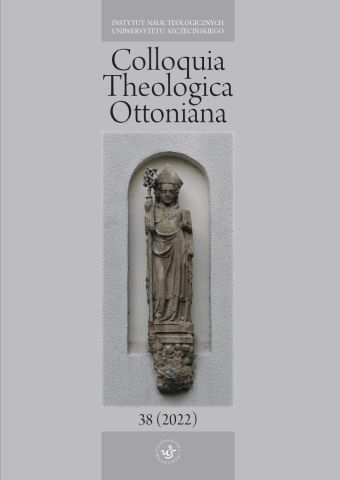
ISSN: 1731-0555
eISSN: 2353-2998
OAI
DOI: 10.18276/cto.2022.38-01




Issue archive /
38/2022
La sinodalità e l’intercomunione in Dumitru Stăniloae
(SYNODALITY AND INTERCOMMUNION ACCORDING TO DUMITRU STĂNILOAE)
| Authors: |
Zoltán
Bara

Universitatea UBB Cluj Napoca |
| Keywords: | Dumitru Stăniloae ecumenism open catholicity (sinodality) union of Churches eucharistic inter-communion |
| Data publikacji całości: | 2022 |
| Page range: | 22 (9-30) |
Abstract
In Dumitru Stăniloae’s work, he takes original, albeit sometimes radical, positions on a great variety of ecumenical themes and problems; however, Stăniloae is always in favor of dialogue. Following Stăniloae’s arguments, I will present two themes that summarize Stăniloae’s original ecumenical vision on the union of the Churches: the theme of catholicity or open synodality, and Eucharistic intercommunion. Stăniloae suggests an open synodality or catholicity as a dogmatic and spiritual opening of the Christian Churches to rediscover their unity. At the basis of this open catholicity is the Sacred Scripture where there are diverse traditions and meanings – differences that come from the diversity of God’s actions in the history of salvation. The Catholic or synodal approach can become, in all the senses of the Scripture, the meeting point for all Christians. On the other hand, in Stăniloae’s vision, Eucharistic intercommunion must be a full Eucharistic communion. Orthodoxy considers the unity of the Church as deeply and ontologically anchored in Christ, and it considers the Eucharist as the mean that sustains this unity. This unity cannot bring the Eucharist down to the level of being psychologically and physically lax among Christians. Indeed, without the unity of faith, and without communion with the body and blood of Christ, the Church could not exist in the full sense of the word; just as without unity in faith and without the Church, Eucharistic communion cannot be achieved. Eucharistic intercommunion makes a separation between the unity of faith and the Church, inconceivable because it leads to the dissolution of the Church, of the unity of faith, and of the Eucharist itself. Communion with the body and blood of Christ cannot be separated from unity in faith or from the conviction that the Church represents a profound ontological unity of the faithful in Christ and among them.
Download file
Article file
Bibliography
| 1. | Bara Z., Un approccio ortodosso ecclesiologico alla dimensione sacramentale della Chiesa: la Chiesa, Sacramento di Cristo, secondo Dumitru Stăniloae, in: Sakramenty nowym wyzwaniem dla Kościoła Katolickiego, a cura di J. Radkiewicz, Szczecin 2019, p. 155–180. |
| 2. | Bara Z., La realtà mistica della Chiesa nella riflessione ortodossa di Dumitru Stăniloae, “Studia Theologia Catholica Latina” 66 (2021) 2, p. 77–107. |
| 3. | Bordeianu R., Dumitru Staniloae: An Ecumenical Ecclesiology, Edinburgh 2013. |
| 4. | Bordeianu R., (In)Voluntary Ecumenism: Dumitru Stăniloae’s Interaction with the West as Open Sobornicity, in: Orthodox Constructions of the West, a cura di E.G. Demacopoulos, A. Papanikolaou, New York 2013, p. 240–253. |
| 5. | Bordeianu R., Ospitalità eucaristica: un’analisi fenomenologica della recente teologia ortodossa, in: Il dono dell’ospitalità. Atti del XXV Convegno ecumenico internazionale di spiritualità ortodossa (Bose, 6–9 settembre 2017), a cura di L. Chremaschi, L.D’Ayala Valva, A. Mainardi, Magnano (BI) 2018, p. 263–285. |
| 6. | Coman V., “Open Sobornicity” and “Receptive Ecumenism”: Fruitful Models of Ecumenical Interaction, in: Just Do It? Recognition and Reception in Ecumenical Relations: Proceedings of the 19th Academic Consultation of the Societas Oecumenica, a cura di D. Heller, M. Hietamaki, Leipzig 2018, p. 241–251. |
| 7. | Coman V., Le Saint Esprit comme liaison de l’amour éternel entre le Père et le Fils: un cas de ‘sobornicité ouverte’ dans la théologie orthodoxe, “Irénikon” 89 (2016) 1, p. 25–51. |
| 8. | Moşoiu N., “Sobornicitatea deschisă” ca tipologie ecumenică sau De la teologia confesională la teologia ecumenică în perspectiva viziunii despre “sobornicitatea deschisă”, “Revista Teologică” 4 (1997), p. 87–117. |
| 9. | Nouveauté dans l’oecumenisme, Taizé 1968. |
| 10. | Roberson G.R., Ecumenism in the Thought of Dumitru Stăniloae, in: T. Damian, G. Alexe, E. Pentiuc, R. Roberson, J. Jonita, L. Turcescu, The Theological Legacy of Fr. Dumitru Stăniloae and its Ecumenical Actuality, Symposium VI/1, New York 1999, p. 43–54. |
| 11. | Stavrou M., Teologia cristiana ortodossa, in: Dizionario del sapere storico-religioso del Novecento, a cura di A. Melloni, Bologna 2010. |
| 12. | Stăniloae D., Sinteză eclesiologică, “Studii Teologice” 7 (1955) 5–6, p. 267–284. |
| 13. | Stăniloae D., Coordonatele ecumenismului din punct de vedere ortodox, „Ortodoxia” 19 (1967) 4, p. 494–540. |
| 14. | Stăniloae D., Iubire și adevăr: pentru o depășire a dilemei ecumenismului contemporan pe marginea întâlnirii ecumeniste de la Taizé, “Ortodoxia” 19 (1967) 2, p. 288–290. |
| 15. | Stăniloae D., Transparenţa Bisericii în viaţa sacramentală, “Ortodoxia” 22 (1970) 4, p. 501–516. |
| 16. | Stăniloae, D., În problema intercomuniunii, “Ortodoxia” 4 (1971), p. 561–584. |
| 17. | Stăniloae D., Sobornicitate deschisă, “Ortodoxia” 23 (1971) 2, p. 165–180. |
| 18. | Stăniloae D., La Liturgie de la communauté el la Liturgie intèrieure dans la vision philocalique (Gestes et paroles dans les diverses familles liturgiques. Confèrences Saint Serge XXV-c semaine d’étude, juillet 1977), Roma 1978. |
| 19. | Stăniloae, D., Dogmatica I, București 2003. |
| 20. | Stăniloae D., Dogmatica II, București 2003. |
| 21. | Stăniloae D., Spiritualitate şi comunione în Liturghia Orthodoxă, Craiova 1986. |
| 22. | Theologen des 20. Jahrhunderts. Eine Einführung, a cura di P. Neuner, G. Wenz, Darmstadt 2002, p. 145–156. |
| 23. | Turcescu L., Eucharistic Ecclesiology or Open Sobornicity?, in: Dumitru Stăniloae: Tradition and Modernity in Theology, a cura di L. Turcescu, Palm Beach 2002, p. 83–103. |
| 24. | Ware T., Church and Eucharist, Communion and Intercommunion, “Sobornost” 7 (1978), p. 550–567. |